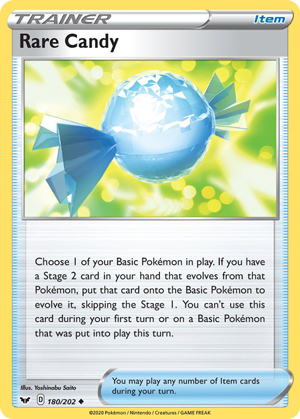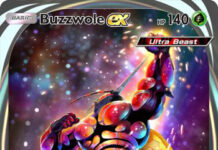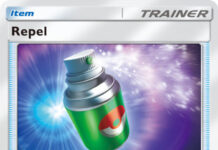
Rare Candy
– Sword & Shield
Date Reviewed:
April 16, 2020
Ratings Summary:
Standard: 3.25
Expanded: 3.25
Limited: 3.75
Legacy:3.50
Ratings are based on a 1 to 5 scale. 1 is horrible. 3 is average. 5 is great.
Reviews Below:
 Vince This week’s Easter Throwback is Rare Candy not only because it is obvious like potentially picking up candies from Easter eggs but also because it has received another print on the Sword & Shield expansion. It is not a new card, however, as it was first debuted in September 17, 2003, where Rare Candy debuted on the EX Sandstorm expansion. And even then, this effect is so familiar, it reminded me of an much older card: Pokemon Breeder from Base Set (which is previously a weaker version before the errata, it’s on par now). Other prints appeared on multiple expansions after EX Sandstorm: -EX Emerald Pretty much in every single generation (except Base Set and Neo series) we have at least a couple prints of Rare Candy in different expansions. I don’t recall a format where Rare Candy wasn’t an option in Standard/Modified, but even if it left rotation, it won’t be long until we have another print in the next expansion or two. It is also another one of those cards where it received a massive errata that actually affected how Rare Candy would be used, but I think it was for the best because whatever the designers previously saw how it was being played made them think that they made the effect much more powerful than it looks. This is actually the seventh review of this card because Rare Candy has been reviewed six previous times. Feel free to read those if you have time. The first four reviews was based on the older effect while the previous two reviews are based on the errata that was given at the time. –October 1, 2003 (pre-errata) So, the various prints between the time EX Sandstorm was released to the day it was issued errata stated this: “Choose 1 of your Basic Pokémon in play. If you have a Stage 1 or Stage 2 card that evolves from that Pokémon in your hand, put that card on the Basic Pokémon. (This counts as evolving that Pokémon.)” Based on the wording, you could: -Use Rare Candy on the first turn of the game (even if you went second) (There is major discrepancy regarding if you’re allowed to evolve anything on the first turn on the game. On the first review, according to Otaku, Nintendo says you can’t evolve any Pokemon on the first turn, even with Eevee’s Energy Evolution, Erika’s Clefairy, or even certain Pokémon from Giovanni. However, on the second review of Rare Candy, some rule changes make it so that you can use it on your first turn.) This, along with Broken Time Space, were cards that can let you “cheat” your way through that you would otherwise had to wait a turn or two to do the same thing. The ability to cheat Evolution made several Stage 2 decks viable during the days between those two expansions’ release dates. Ultimately, the best of Stage 2s were able to compete against Basic Pokémon because they got better Pokémon Powers and/or attacks that can allow them to either hold their own in battle and/or supporting your other Pokémon or yourself, which means other Stage 2s that lack some of those features were dismissed despite the speed Rare Candy provides. Eventually, the errata was issued the day the Black & White expansion was released. I’m pretty sure players are aware of such errata from social media or even the Theme Decks of Unova Starters (that Theme Deck has a separate sheet of paper that lists the errata issued for Rare Candy, Plus Power, Defender, Potion, and Great Ball). So even if such cards were or were not receiving any further prints, the errata still goes into effect whatsoever. Cards that were issued errata doesn’t require you to bring out your external resources as reference since everyone should know, but just in case they still aren’t aware of the changes and insist on using older effects, you can always consult a Judge to settle such discrepancies. Anyways, here’s the latest errata from the Sword & Shield set: “Choose 1 of your Basic Pokémon in play. If you have a Stage 2 card in your hand that evolves from that Pokémon, put that card onto the Basic Pokémon to evolve it, skipping the Stage 1. You can’t use this card during your first turn or on a Basic Pokémon that was put into play this turn.” Well, this card’s effect made it pretty clear, which caused players to NO LONGER: -use it on the first turn on the game (even if the player goes second), The state of the format we’re in has ensured that there will be little to no opportunities to make player cheat evolution on turn one. Sure, there was Forest of Giant Plants and Wally that still lets you evolve certain Pokémon on the first turn or the turn the Basic Pokémon was played, but eventually those cards were rotated from Standard and was banned from the Expanded Format due to balance issues. Other cards still lets you evolve on the same turn, but makes you use up an attack such as Diancie’s Sparkling Wish (letting you evolve your Pokemon one stage at a time) or Rowlet & Alolan Exeggutor-GX’s Super Growth (which could evolve your Basic Grass Pokémon all the way up to Stage 2). Meganium from SM Lost Thunder is perhaps the chief user that emulates the pre-errata Rare Candy via Early Ripening Herb Ability, letting you evolve your Basic Pokémon into a Stage 2 even if it was put into play, but Meganium itself is a Stage 2, so you still need to Rare Candy your Chikorita before you benefit from this ridiculous ability. Ironically, that last bit of text (You can use this ability during your first turn…) is useless because you can’t get Meganium in play on your first turn. Looking at World Championship decks, decks that uses Stage 2s also ran a full four of Rare Candy, and the decks between 2003 to 2010 were under the pre-errata version of this card, so that means they can get a Stage 2 in play on the same turn you played a Basic Pokémon or on your first turn. Even after Broken Time Space debuted on Platinum, the decks that used Broken Time Space still ran a full four of Rare Candy. Only those other decks that didn’t use Rare Candy didn’t have a focus of Stage 2s. Now let’s look at other World Championship decks between 2011 to 2019. Rare Candy was seldom used, which makes sense when you see the decks they they’ve used. Most of them was focused on big Basics (like Basic EX/GX Pokémon) and/or Stage 1s (like Garbodor’s Garbotoxin or Zoroark-GX’s Trade) backing up your main attacker or helping the player. Successful Stage 2 decks – between that time period – that made it to the semi-finals are a rare sight to see and placed well enough to have their deck become replicas (as in the entire deck copied verbatim for the players to play test but can’t be used at official tournaments) include Ross Cawthon’s The Truth and Diego Cassiraga’s Gardevoir-GX deck. Jacob Van Wagner’s Honorstoise Deck also won 2015 Worlds Master Division and did contain a couple copies of Stage 2 Blastoise cards, but did not contain lower stages like Squirtle and Wartortle due to a Supporter card named Archie’s Ace in the Hole letting you play a Water Pokemon from your discard pile onto your Bench if he’s the only card in your hand. That tremendously saves deck space at the cost of meeting a requirement to play him (which isn’t that hard to achieve due to a good amount of options to reduce your hand size like Ultra Ball) and it makes sense not to use Rare Candy in this case. Rare Candy has been significantly weaker from the errata that was issued almost nine years ago, but it is still an integral piece of support for decks running Stage 2 Pokémon UNLESS the entire evolutionary line have alternative methods of evolving without the need to use Rare Candy (like Adaptive Evolution Caterpie & Metapod), or if they have certain traits that makes Rare Candy not worth skipping the Stage 1 for specific evolutionary lines like Frogadier’s Water Duplicates (which could summon three more Frogadier from your deck into your Bench) and/or Drizzile’s Shady Dealings (which lets you fetch a Trainer card). Or how about Eelektrik’s Dynamotor ability that replenishes Lightning energies?! Seems superior against every single Eelektross cards we’re seen so far! And based on some of the examples mentioned a paragraph earlier, it seems like Rare Candy already faced competition from such alternatives. Not by much though; Meganium isn’t in every Stage 2 deck due to using up more deck space just to fit the entire evolutionary line (even if it was a 2-0-2 line), making Rare Candy efficient in some situations. Others like Rowlet & Alolan Exeggutor-GX’s Super Growth only works for Basic Grass Pokémon. Because of other alternatives being so specific, Rare Candy remains to be relevant for however many years to come. And it’s also a good thing that Rare Candy also works for Stage 2 GX Pokémon because it ain’t much different than a non-GX Stage 2 Pokémon; they’re both technically Stage 2 Pokémon! In Limited, the only reason not to use Rare Candy is if you didn’t pull any worthwhile Stage 2 Pokémon to use, if you’re missing pieces to complete the evolutionary line, or if you have a certain evolutionary line not worth skipping the Stage 1. In Legacy, it is still a very good card, and although the amount of competitive Stage 2 Pokemon seems small, that is enough for Rare Candy to see some usage. Empoleon (Diving Draw’s discard one card draw two), Blastoise (unlimited Water energy attachments to anyone), Hydreigon (Dark Trance to move Dark Energies around), and others would love to use Rare Candy to quickly evolve their respective Basics into Stage 2s so that they can utilize their abilities to help certain Pokémon or even the player. Even if you tried to use the HS Unleashed print which had the pre-errata effect, the PTCGO will still enforce the new errata and override older errata, so unfortunately you cannot exploit the older effect in this format. But the lack of competition in the Legacy Format (I don’t recall any card besides Rare Candy – between HGSS and BW Legendary Treasures – that has something to do with evolving your Pokemon) helps Rare Candy case, as well as couple nerfs like Pokémon Catcher which requires a successful coin flip (before 2013 it acts like Gust of Win) and players going first cannot declare an attack, so Stage 2 decks are somewhat safe with those changes! Before I get to the ratings, when reading older reviews of Rare Candy, I am pretty shocked that most of the reviews that I’ve read were extremely favorable, with some giving them near-perfect marks (I know a certain active reviewer that used to give 4.95/5 before the errata and 4.5/5 after the errata), but I don’t think it will ever live up to those scores nowadays. There’s just so many factors affecting your decision whether or not you would put Rare Candy in your deck based on the errata. Item lock, not getting your evolutions in time, good Stage 1 in certain evolutionary lines that’s not worth skipping the Stage 1, and the risk of being devolved from a Stage 2 into a Basic Pokémon just after you evolved them (albeit rare)…these affect Rare Candy’s viability. There are some decks that don’t need it because they don’t use Stage 2s and there might be other decks that uses Stage 2s that NEED Rare Candy, which makes it become a pretty average card as a whole; it does a good job at a specific situation but useless on others. If I were to rate Rare Candy for Unlimited, because of the errata that prevented you from using it on your first turn or the turn you put a certain Pokémon into play, it would be inferior (but still a good card) because Broken Time Space is one of the few cards which can let you evolve your Pokémon in the same turn while Rare Candy couldn’t, even going as far as evolving from a Basic Pokémon into a BREAK Evolution of a Stage 2! However, because Broken Time Space needs exactly the Basic, Stage 1, Stage 2, and/or BREAK Evolution of a Stage 2….in your hand, you occasionally not be able to have them in time. The hand economy is worse than Rare Candy; playing Broken Time Space becomes a -4 or even a -5 on hand economy due to exactly needing that Stadium card, Basic, Stage 1, and a Stage 2 in your hand…………while Rare Candy is a -3. In the case of Rare Candy, the things you need in your hand is, of course, Rare Candy, a Basic, and a Stage 2 Pokemon. Not to mention that your particular 4-4-4 line could cause some of them to be prized; If several of your Stage 1s are prized (while you still got 4 of each Basics and Stage 2s), then you better need to rely on Rare Candy more than Broken Time Space. Ratings: –Standard: 3.5/5 Conclusion: Rare Candy is one of those cards where a group of players would complain that this effect is broken while the other group complains that they have to wait a turn for their Basic Pokémon to evolve (and hope they don’t get item locked or that their desired evolving basics survive). But the effect – errata or not – won’t please both of them. If the developers want to revert back to the pre-errata effect, then they would let everyone know, but until then, we have to deal with the errata we’re given nine years ago, and it still does a good job helping Stage 2s despite couple nerfs. |
 Otaku Rare Candy has a long history, and Vince has done an excellent job of going through it; if you’re looking for a detailed account of Rare Candy through the years, he’s got it covered! So I’ll just go with my other usual approach. Rare Candy is a Trainer-Item that has you choose one of your Basic Pokémon in play, then play a Stage 2 that evolve from something that evolves from it directly onto it, skipping the Stage 1 form. It also states you can’t use it on the first turn a Basic Pokémon is in play, or during a player’s first turn. Though it varied due to ruling and rule changes, prior to the errata it received near the start of the BW-era, its effect had two important differences. First, you could use it to play a Stage 1 directly onto the corresponding Basic. The second big difference is why that matters; you could use Rare Candy the first turn Item-cards were allowed, even the first turn of the game… at least, when the T1 rules allowed it and the rulings allowed it (at different times, both said “no”). This meant even some Stage 1 decks would consider using Rare Candy for extreme speed, while decks running (unrelated) Stage 1 and Stage 2 evolution lines might include a few extra to burn on the Stage 1. Speaking of Stage 1, both versions of Rare Candy detract from their usefulness. Even the modern Rare Candy still lets a Stage 2 hit the field a turn earlier, so it takes a crazy good Stage 1 to overcome such a speed boost. Still, it was typical to include at least one of the Stage 1 form unless it was a TecH (1-o-1) Stage 2 line. Why?
Pokémon are easier to search out and recycle, at least, most of the time. On the other hand, we don’t see a lot of successful, anti-evolution effects in the game, but (in Expanded), you know you can’t count on always having access to Items. A few sets after Rare Candy, we had powerful devolution you could use against your opponent, and sometimes we’ve had devolution or bounce effects that work well with your own Pokémon… unless they used Rare Candy to hit the field earlier. All versions of Rare Candy have pretty much been staples for Stage 2 decks. Only a select few wouldn’t include at least one for a quick burst of speed whenever it worked out. An example of where it doesn’t really work at all is Lost March: you want your Hoppip to evolve into Skiploom (SM – Lost Thunder 13/214), then use its Ability that sends itself (and all cards attached) to the Lost Zone while Benching a Jumpluff from your deck. In the Limited Format, if you have the corresponding Basic and Stage 2, and a deck where they even remotely fit, you run them. Even if you also pulled and are running the Stage 1 form. Ratings
Rare Candy is useless for decks that don’t need to speedily evolve into a Stage 2, and even a handful of those have alternative needs. Honestly, I don’t like it. Not in a way that affects its scores, but because I think it screws with game balance. All Stage 2 Pokémon have to be preemptively “nerfed” to avoid issues with Rare Candy, and one of the best uses for Evolutions is “locking away” effects that are broken if they hit the field too soon. I think it may contribute to the idea that evolving Basics and Stage 1 Pokémon are just “stepping stones”. |
We would love more volunteers to help us with our Card of the Day reviews. If you want to share your ideas on cards with other fans, feel free to drop us an email. We’d be happy to link back to your blog / YouTube Channel / etc. 😉
Click here to read our Pokémon Card of the Day Archive. We have reviewed more than 3500 Pokemon cards over the last 17+ years!



